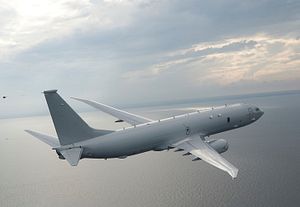The U.S. Navy has awarded U.S. aircraft maker Boeing a $2.4 billion production contract for the next batch of 19 P-8A Poseidon maritime patrol aircraft. The contract modification includes 10 P-8A aircraft to add to the current inventory of the U.S. Navy, five P-8As for the Royal Norwegian Navy, and the last batch of four P-8As destined for service in the British Royal Navy, bringing up the total number of P-8A aircraft in the British military to nine.
The United Kingdom and Norway are acquiring the P-8A aircraft through the U.S. Department of Defense’s Foreign Military Sales process. The United Kingdom will receive its first aircraft in 2019 and Norway will begin receiving the first aircraft in 2021. The U.S. Navy is expected to receive its 10 P-8As by March 2022. In July 2017, the United States, Norway, and Great Britain signed a trilateral statement of intent to acquire the P-8A aircraft in order to step up their military presence in the North Atlantic region.
The P-8A is the military variant of Boeing’s Next-Generation 737-800 commercial aircraft. Originally, it was designed to replace the U.S. Navy’s fleet of P-3 Orion maritime surveillance aircraft. It is thought to be one of the world’s most advanced anti-submarine warfare aircraft currently in service and has long-range anti-submarine warfare; anti-surface warfare; and intelligence, surveillance, and reconnaissance capabilities.
With an estimated operational range of up to 7,200 kilometers (4,500 miles) without refueling, the P-8A aircraft can carry up to 129 sonobuoys for anti-submarine warfare operations. Furthermore, the P-8A can carry several types of bombs, Raytheon Mark 54 lightweight torpedoes, mines, and depth charges. It can also launch air-to-surface missiles installed on the two weapons stations on each wing. As I wrote elsewhere, the U.S. Navy variant of the P-8A will be equipped with a new system for launching torpedoes:
The new aircraft are also slated to be armed with the so-called High Altitude Anti-Submarine Warfare Weapon Capability (HAAWC), a new torpedo upgrade that can release a MK54 torpedo, fitted with an air-launched accessory kit that includes a GPS guidance system and folding wings, from altitudes of 30,000 feet (9,100 meters) or higher — it essentially turns the torpedoes into glide bombs.
HAAWC would permit the P-8A to operate from higher altitudes during anti-submarine warfare operations, avoiding detection by enemy submarines. In comparison, P-3 Orion aircraft have to descend to an altitude of around 100 feet to release their torpedoes and engage targets exposing them to low-altitude anti-aircraft defenses.
The U.S. Naval Sea Systems awarded Boeing a $9.3 million contract modification for the integration of the HAAWC on the P-8A Poseidon on January 11.
The aircraft is also fitted with an in-flight refueling system, and advanced sensors, including an APY-10 radar system. Notably, the P-8A has the capability to control a number of unmanned aerial vehicles (UAVs), increasing the aircraft’s coverage and reach.































